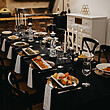In this week’s Grocery Great segment, guest writer ForXx discusses the differences between pickle brands and varieties.

As they nursery rhyme goes, Peter Piper picked a peck of pickled peppers. And there is a distinct difference between those pecks of pickles. Take for instance the household name: Claussen’s dill, crunchy goodness. Now, compare it to the Vlasic Kosher pickle. What’s the difference? Believe it or not, it’s the color. A fresh pickle is never boiled first. Claussen, for example, are light green compared to some others that are dark green which would indicate it had been previously boiled. As far as calories, there is too little a difference to count–only five and that must be from the water retention gained by the 450 ml of sodium.

So what’s the difference between a kosher pickle and a dill? A pickle is usually labeled “kosher” when the components and the handling of the food meets Jewish religious requirements for cleanliness (no pork products within, clean handling, etc.). That something is “kosher” as indicated on the container by a little “K” in a circle. Conservative and Orthodox Jews typically keep kosher homes. For something like a pickle, where there would be some restrictions on the ingredients used. For example, corn syrup might be prohibited as an ingredient.
So who eats pickles? In 1933, per capita pickle consumption was 2.09 pounds. By 1974, consumption grew to eight pounds. Today people eat more than nine pounds per person per year. My Grocery Great is Vlasic, Kosher Dill–snappy, crunchy, fresh goodness.
Grocery Great: Pickles










